Peter Huessy
John Isaacs, a Senior Fellow at the Center for Arms Control and Non-Proliferation, writes in the National Interest on December 17, 2022, the number of nuclear weapons that the United States needs for deterrence is somewhere between two and three hundred warheads, some ninety percent less than the current force endorsed by the recently released 2022 Nuclear Posture Review. He further declares that the United States can unilaterally reduce its numbers irrespective of the warhead levels deployed by China and Russia, which combined now approach three thousand deployed strategic warheads.
He bases this number on what is needed to deter Russia and China, or Iran or North Korea, on the notion that three hundred nuclear warheads detonated on Russian soil have the same destructive capability similar to the metrics adopted by former Secretary of Defense Robert McNamara as what was needed to deter the Soviet Union at the height of the Cold War—which was to kill at least one-third of the Russian people and two-thirds of their industry.
However, McNamara was counting on a US force of many thousands of warheads. How one hundred deployed retaliatory weapons could achieve such destruction is not revealed by Issacs.
The basis for his plan starts with the premise that nuclear weapons are so destructive they have no utility on the battlefield and thus only can be used for deterrence, but, if necessary, engage in a retaliatory strike on Russian cities as a deterrent threat against Moscow using nuclear weapons first on the United States.
Apart from the horribly immoral nature of Issacs strategy, he forgets that totalitarian powers such as Russia and China killed 125 million of their own people simply to stay in power. They thus do not value their people. As Mao stated, losing a few hundred million people in a nuclear war didn’t bother him because as he said at the time China had many millions more people.
‘Issacs strategy would leave America’s adversaries with their nuclear weapons in a complete sanctuary, from which they can fire at will at the United States. Issacs must be aware of the period after Eisenhower’s deterrent strategy of massive retaliation was devoted to adopting a flexible response capability, a switch starting in the Kennedy administration. The US does not attack cities and population centers, although Russia does as the world has seen in Ukraine. The US nuclear conflict targeting strategy is to hit four classes of targets: a) Nuclear Forces, b) Nuclear Infrastructure, C) Nuclear C3 Forces, and d) Political nuclear entities.
The entire post MAD or mutual assured destruction strategy by the United States has been to hold at risk our adversaries most deadly weapons so that any first use of such weapons against the United States will result in the US in a retaliatory strike eliminating the enemy’s remaining weapons. Not destroying their entire society. And without these reserve weapons these enemies cannot enforce their hegemonic ambitions which would probably be the basis for their strike against the US in the first place.
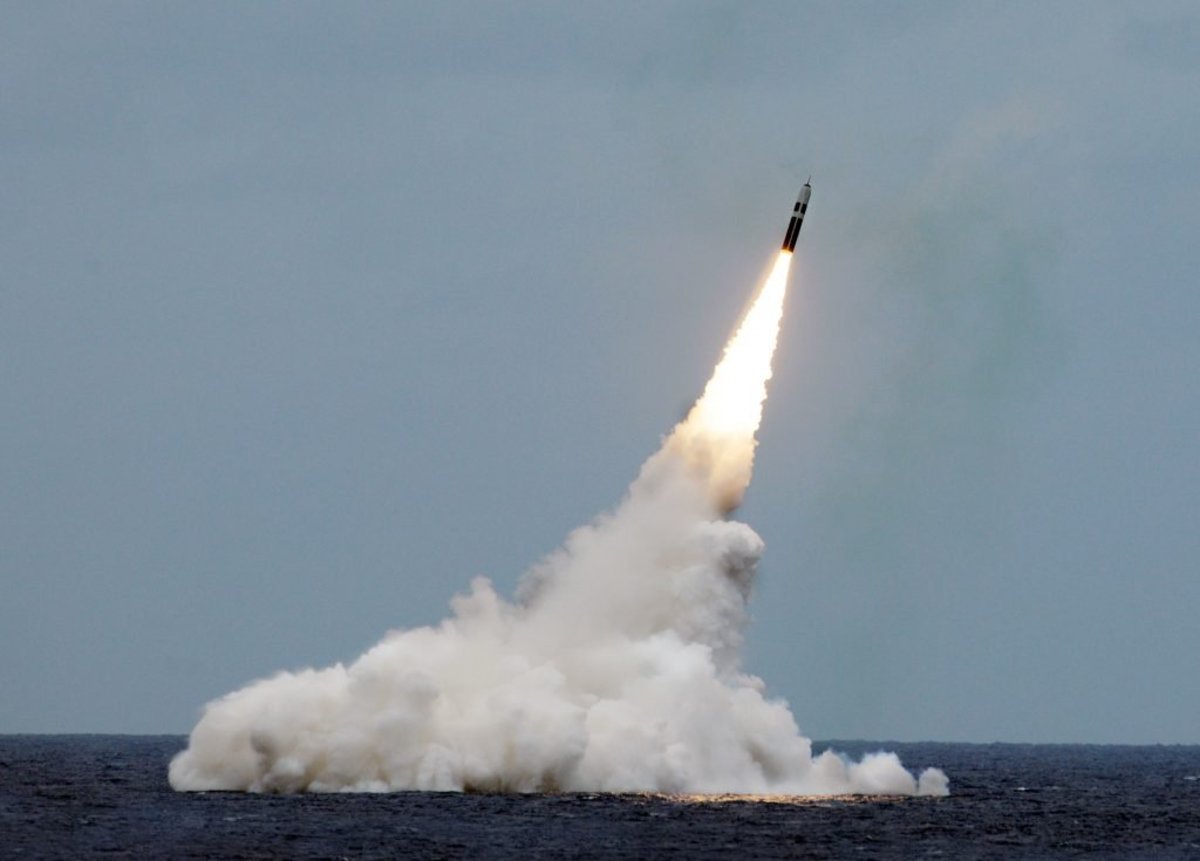
Trident-D5 Submarine ICBM
Critically important is that Issacs doesn’t indicate how he would deploy America’s two or three hundred nuclear warheads but his longtime opposition to deployment of any ICBMs gives us a clue. If the US deployed these warheads on submarines such as the new Columbia class, each with 16 missiles, and each missile armed with three warheads, the United States could deploy all three hundred warheads on six submarines.
But our submarine force is not simultaneously deployed as one third of the subs would be undergoing a backfit, one-third would be in transit from or to the sub-bases, while one third would be on patrol. At most, one hundred warheads would be available for a retaliatory strike, implying the inability to hold at risk only a handful of Russian or Chinese military targets.
It is true, a simple city busting deterrent strategy using one hundred warheads could kill 20-50 million Russian people while destroying much of Russia’s fifty largest cities. But such a retaliatory strike would not eliminate a single Russian weapon aimed at the United States. And importantly, as David Trachtenberg of the National Institute of Public Policy has recently written, the US does not now have nor is it going to adopt a deterrent strategy of burning cities to the ground.
Further, Issacs minimalist strategy has serious flaws even beyond its fundamentally immoral character. It would be highly dangerous and potentially invite a disarming nuclear attack against the United States. For example, Mr. Isaacs’ minimal deterrent would reduce the US nuclear assets from over five hundred to six, a nearly 99% cut. For example, if the United States maintained six submarines at two ports, the targets the Russians or Chinese would need to destroy to put the US out of the nuclear business would be six: two nuclear submarine bases with one submarine at each, two submarines in transit and two submarines on patrol.
A bomber and submarine force as an alternative would not be much better—each leg of this DYAD would have at most 100-150 warheads. The bombers, however, are not fast flyers, and although with great capability, they still of course must reckon with air defenses, as well as the time it takes to get to target.
A 100-150 warhead reserve for submarines implies 30-50 missiles if each missile holds three warheads. That further implies two or three submarines, the possible end of a two-ocean deterrent force, only one Navy base, and a very minimal deterrent force in the face of a rising Russian and Chinese nuclear buildup, including only a handful of nuclear deterrent assets on which would rest the entirety of the US nuclear deterrent and extended deterrent for our allies.
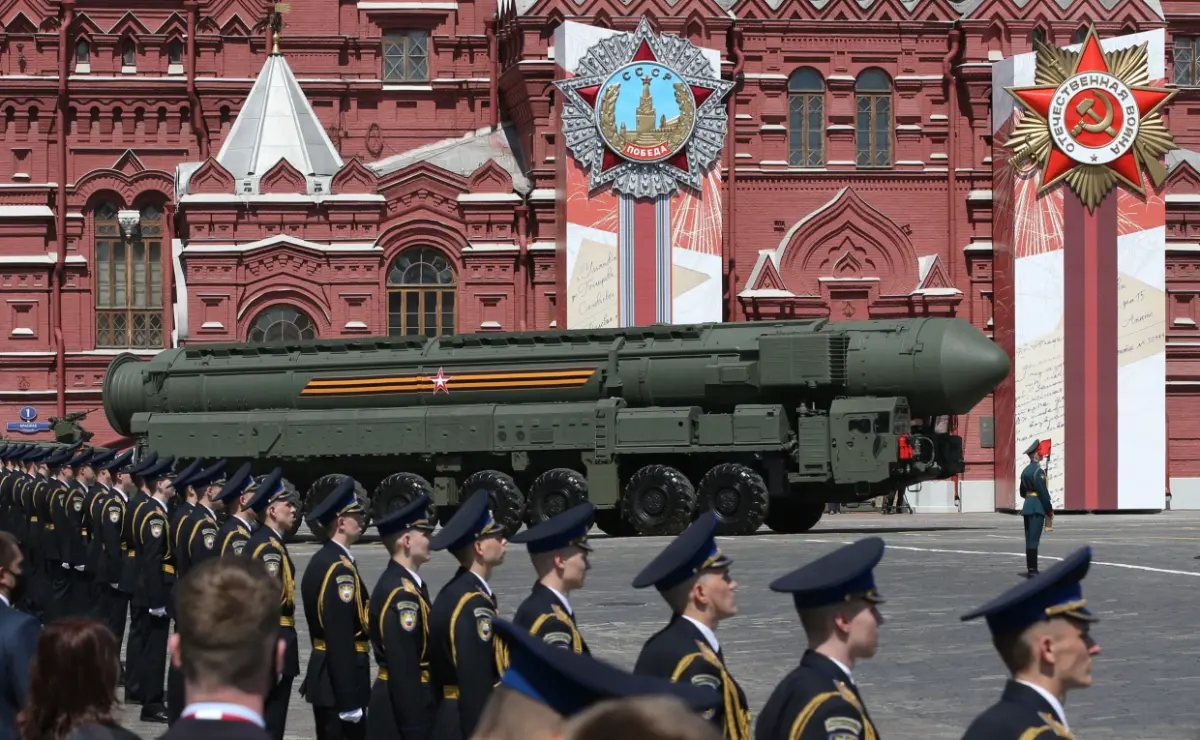
Russian nuclear missiles drive along Red Square during the military parade marking the 75th anniversary of the Nazi defeat, on June 24, 2020, in Moscow.
With a breakthrough in anti-submarine warfare, just a small handful of Russian or Chinese conventional or nuclear munitions could eliminate the entire US nuclear deterrent. What then is the point of potentially making it easy for our enemies to disarm us?
Isaac refers several times that the US is engaging in an arms race toward more nuclear weapons, apparently forgetting that the twelve thousand nuclear warheads the US once deployed have been “reduced” by ninety percent, a very big accomplishment indeed.
However, what Issacs doesn’t say is the organization of which he has been part for half a century didn’t initially support the 90% reduction in nuclear warheads that has occurred under the START I treaty, and subsequently under the Moscow SORT, and New START agreements.
Issacs supported a nuclear freeze not the START I agreement that reduced accountable weapons by fifty percent, a remarkable achievement that the smart folks in Washington told Reagan was not possible. The arms control community universally said the Reagan proposal for reductions was a trick, including the proposal to eliminate all the Soviet SS-20 missiles in Europe and Asia, known as the zero-zero option. The trick was proposing reductions the Soviets could not possibly accept, thus with the US pretending to support arms control but knowing the US proposals would never be adopted, and a major US arms race could continue.
And as for the 2002 Moscow or SORT agreement, that further 75% cut in nuclear weapons was dismissed by the disarmament folks as “not real arms control” because it was not a detailed multiple hundreds page document.
The 1981 freeze proposal was a Soviet trick as at the time Moscow’s nuclear modernization effort was complete while the United States nuclear modernization effort had barely begun. A freeze would put the US over a proverbial nuclear barrel.
Issacs also opposed most of the Reagan era nuclear modernization programs which ironically without which we would not have the entirety of our current legacy nuclear forces—which a nuclear freeze would have stopped from being built. And the Reagan nuclear modernization plan was within the boundaries of the 1972 SALT agreement, hardly a reckless or unwarranted expansion of nuclear weapons as Issacs claims.
Although Issacs mistakenly opposed President Reagan’s proposals on arms control and missile defense, Reagan’s strategy was extraordinarily successful in reducing nuclear weapons deployed in the strategic theater by 90%, while ending the Soviet empire and the first Cold War, while also liberating hundreds of millions of people from the bandages of communism.
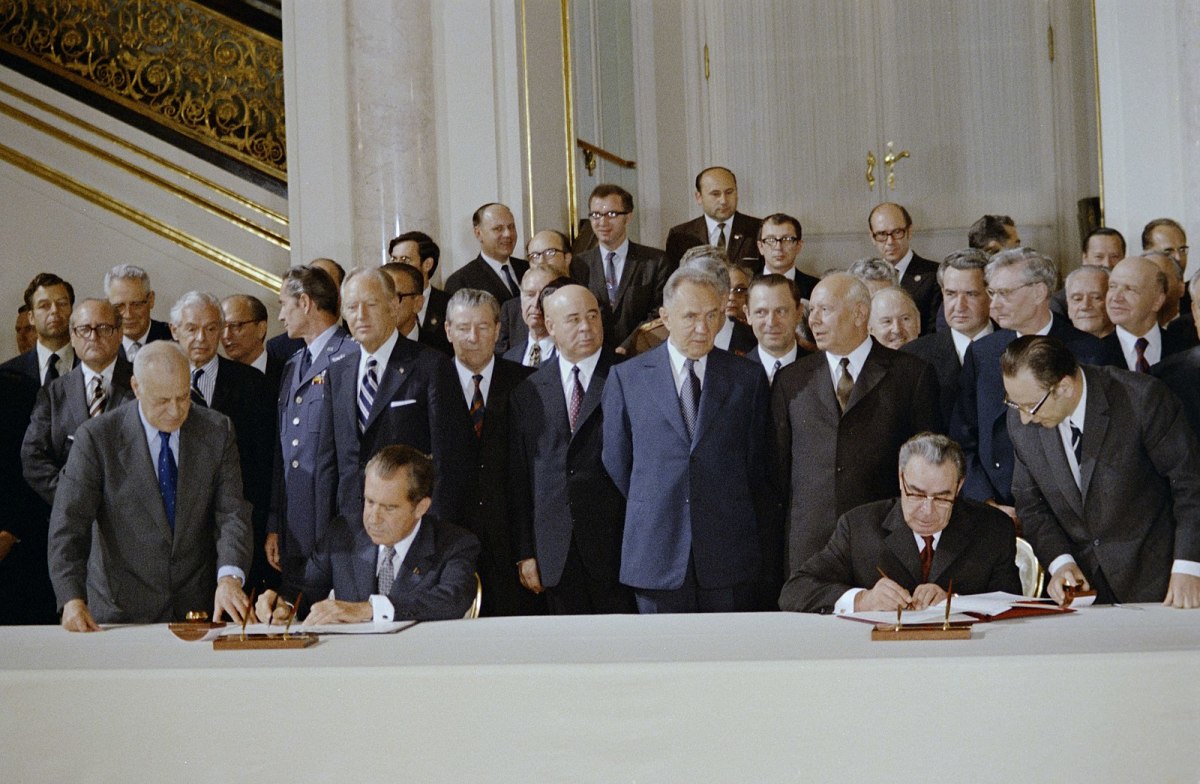
President Richard Nixon and Leonid Brezhnev of the USSR Sign the Anti-Ballistic Missile (ABM) Treaty and Interim Strategic Arms Limitations Treaty (SALT) Agreement in the St. Vladimir Hall, Grand Kremlin Palace, Moscow, May 26, 1972
The dimensions of Reagan’s achievement needs to be better appreciated. Like the China buildup today, Issacs was unconcerned with the Soviet build-up Reagan warned about in the post 1972 SALT era that led to the window of vulnerability.
However, following Reagan’s election, Issacs and his disarmament colleagues campaigned against the deployment of the Peacekeeper and Small ICBM, precisely because they now claimed the large Soviet ICBM force threatened to take out in a bolt out of the blue the entirely of America’s 1000 ICBMs, exactly the very basis for Reagan’s concern over a growing window of vulnerability
Reagan resolved the “window” through building a new Triad of nuclear forces that were more survivable, new arms control that eventually cut deployed strategic Soviet and Russian forces some 90%, and dismantling the Soviet empire, and in so doing slammed shut the dangerous window of vulnerability the Soviets had created.
The window vulnerability was a phrase coined by then candidate Ronald Reagan to describe the massive Soviet force capability built after the signing of the 1972 SALT arms control agreement that allowed for the increase of Soviet nuclear weapons from roughly 2000 to over 13,000 strategic warheads as described in a speech by member of Congress Dan Coates.
Isaac support for a nuclear freeze would have frozen in place a major Soviet modernization advantage over the United States as well as prevented huge numbers of nuclear warheads from being dramatically reduced by Reagan’s inspired nuclear arms control agreements.
It is puzzling that Isaacs now says numbers don’t matter. Of course, if numbers don’t matter, then why is it that every arms control agreement the United States signed with the USSR and then Russia called for both sides to have no more nuclear warheads deployed than the other guy certainly implying that numbers do matter. In short, if numbers don’t matter, why have arms control in the first place?
The missing analysis by Mr. Isaac is that the Russians and the Chinese believe that numbers matter. (As apparently do the North Koreans which recently announced their goal of having the most formidable nuclear forces on the globe.
Issacs says we do not need to worry because the Chinese may have only 400 warheads deployed today. But they also have over twenty new nuclear systems undergoing deployment or development, which could easily give them a nuclear force more than 3000 warheads by 2035, a conclusion reached by several recent expert assessments including those by James Howe, Rick Fisher, Tony Cordesman, and this author.
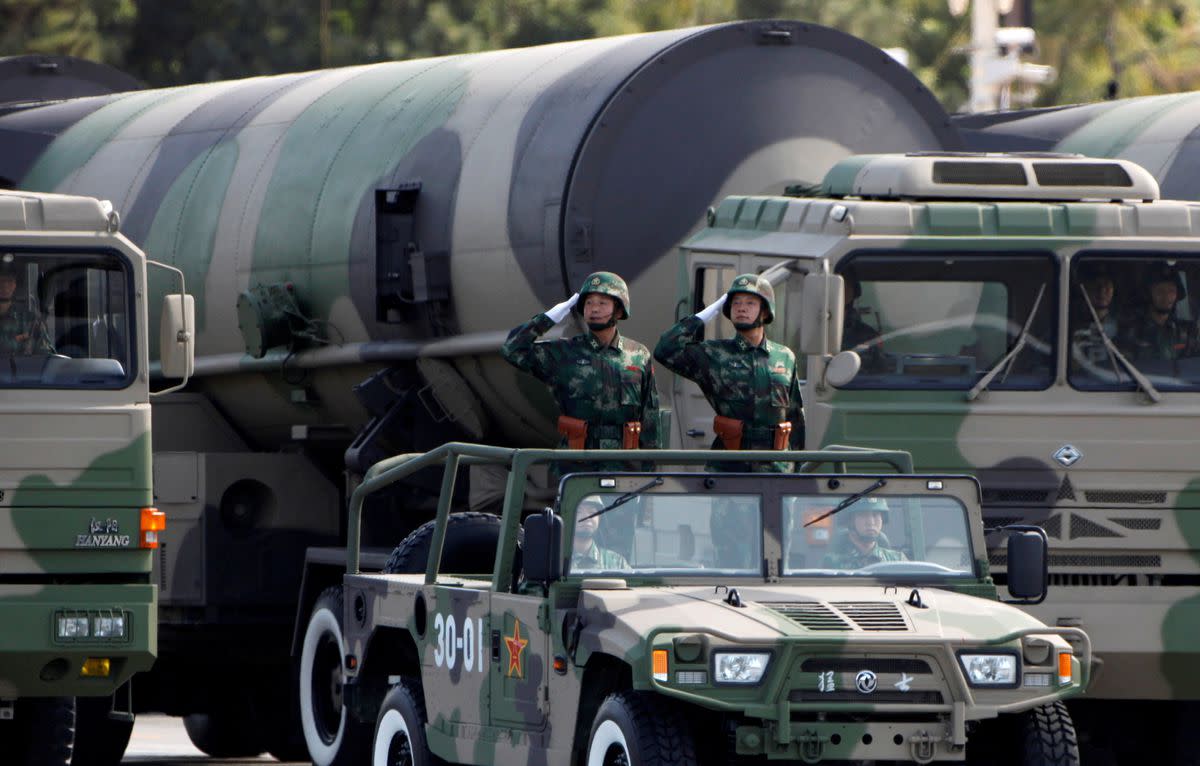
People's Liberation Army (PLA) soldiers salute in front of nuclear-capable missiles during a massive parade to mark the 60th anniversary of the founding of the People's Republic of China in Beijing October 1, 2009. REUTERS/David Gray/File Photo
Unfortunately, many in favor of global nuclear zero or a minimal deterrent strategy, have fallen for the fake Chinese narrative that while they’re increasing their military and economic might it is all a peaceful rise posing no threat to the United States.
Part of this Chinese fairytale has been to conclude that China only has a minimal deterrent of a few hundred nuclear warheads, has insufficient fissile material to build more, does not engage in any arms racing, has not transferred nuclear weapons technology to any country, and will never use nuclear weapons first or against a non-nuclear armed country.
We know now that these Chinese narratives often repeated without question by the US disarmament community and even elements within the US intelligence community are without foundation.
It is obvious a Chinese nuclear force of 1500 warheads is not a minimal deterrent.
Threatening Japan with nuclear Armageddon as China has done is not showing restraint about using nuclear weapons.
Announcing as Deng Xiaoping did secretly in 1981 to the Chinese Communist Party Politburo that China would actively transfer nuclear weapons technology to Pakistan and North Korea and subsequently through the Khan network to Libya, Iran, and Iraq is not complying with the nuclear nonproliferation treaty (NPT) prohibition against transferring nuclear weapons technology.
And as the recent DOD report confirms, the NPEC assessment that China has sufficient nuclear fissile material to build thousands of nuclear weapons was right.
Should the United States take Mr. Isaacs advice and build only three hundred nuclear warheads based on six submarines, two of which are on patrol at any one time, the US very small deterrent retaliatory capability could be largely destroyed by the deployment of a robust Russian and Chinese missile defense, cutting the US deterrent capability to such low levels as to render it ineffective, a development that would seriously undermine the US extended deterrent over NATO and the Western Pacific..
Let’s look at some numbers. China has built 360 new ICBM silos in which the DF 41 can be deployed, with each of these missiles capable of carrying anywhere from 3 to 10 warheads.
The Chinese also are deploying six nuclear armed submarines, each of which has a JL2 or JL3 missile capable of carrying anywhere from 1-10 warheads.
In addition, China has newly deployed strategically armed nuclear bombers each of which can hold multiple gravity bombs or cruise missiles.
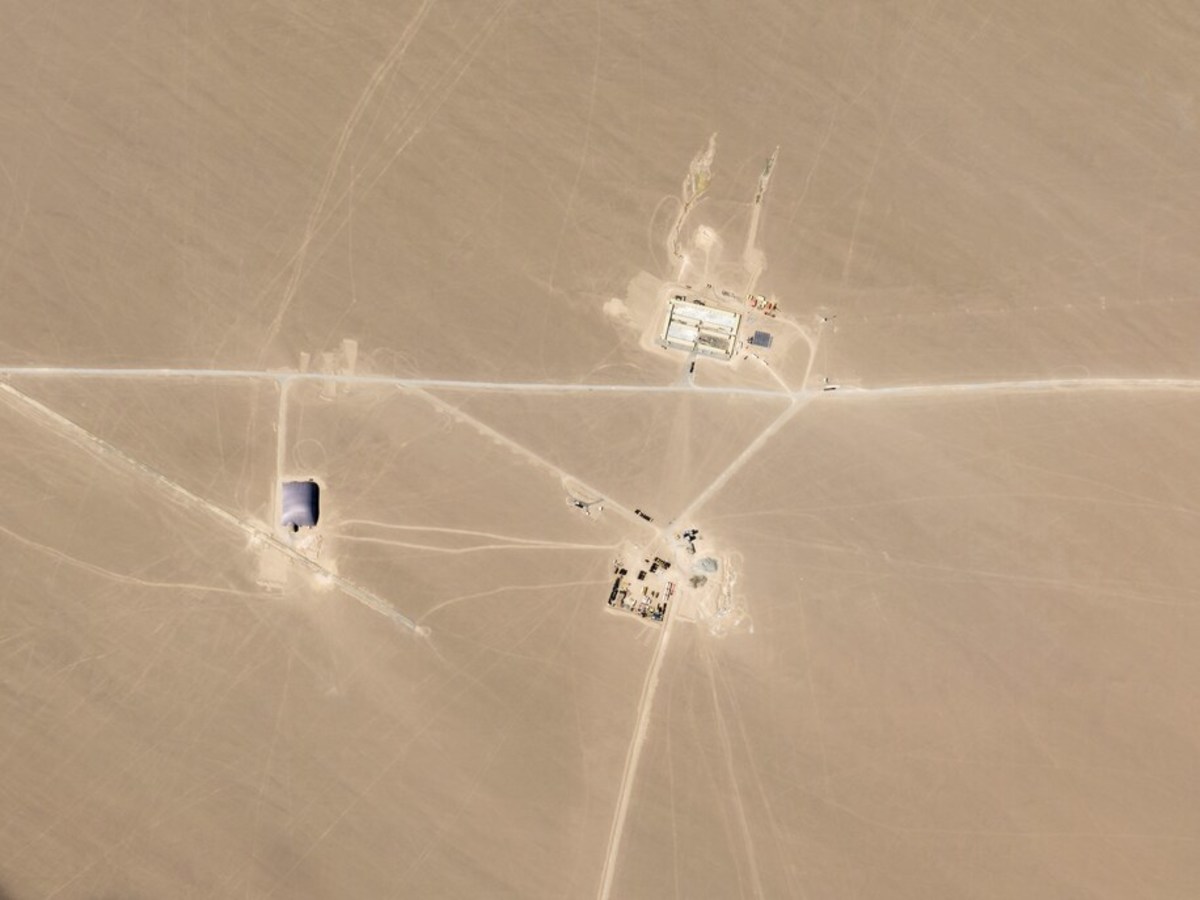
China ICBM Silos
Not only does China have 360 new ICBM silos but additional rail mobile ICBMs on which they spent on the order of $55 billion in a series of tunnels and railroad tracks carrying mobile land-based ICBMs, as military expert Phil Karber has explained.
Add to this force are at least 200 medium range theater Chinese ballistic missiles that can carry nuclear warheads, and China’s emerging theater range nuclear capability matches in numbers all US theater nuclear forces in Europe.
Most importantly however the critical issue here is what China and Russia intend to do with their nuclear deployments whether 400 or 3000 warheads.
Russia has long adopted a policy of nuclear weapons being a guarantor of Russian aggression, which can be undertaken while the United States is intimidated to stand down. In this sense, nuclear weapons are not deployed to deter and make sure aggression fails but allow aggression to succeed.
The Chinese apparently may also adopt such a strategy implying that the adoption of a US minimal deterrent nuclear strategy plays right into the hands of the Chinese and Russian military as both are seeking to use nuclear weapons to coerce and blackmail the United States as they both seek hegemonic roles to spread their brand of totalitarian communism.
Key to this was an April 29, 1999, decree issued by President Yeltsin of Russia in which he called upon the Russian industry to develop battlefield nuclear weapons that were usable--- highly accurate and low yield which would enable Russia to escalate to win a conventional battle using nuclear weapons.
Russia has built thousands of such weapons under the direction of President Putin and as we have seen in Ukraine, Putin has threatened multiple dozens of times to use nuclear weapons against the United States or allies should the United States move its conventional military forces into the region to defend Ukraine.
It is highly likely that China has developed a similar strategy with respect to Taiwan.
Although strategic nuclear weapons have been markedly reduced in the United States and Russia through arms control, the Chinese are under no arms control limits with respect to both their strategic nuclear weapons and their theater systems.
Mr. Isaacs claims the United States has a stockpile of over 5000 nuclear weapons, but a significant number of these weapons are being retired and dismantled, while the available war warheads for deployment or reserve requirements are significantly less, probably around 3600.
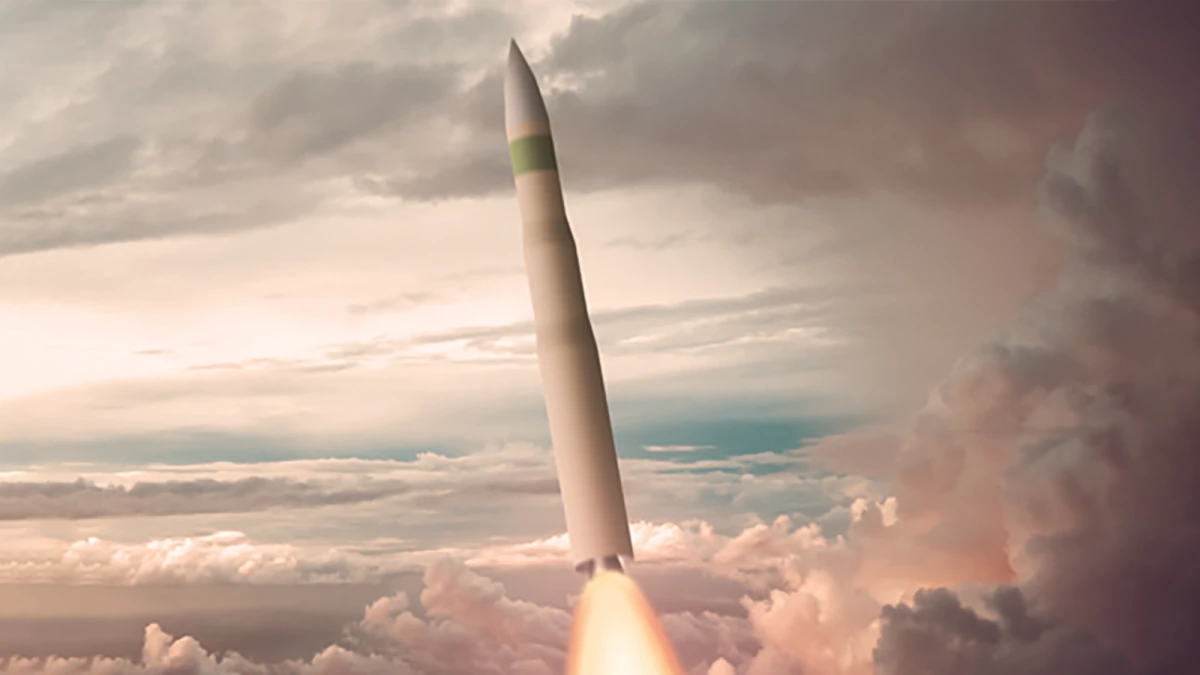
US Air Force artist’s rendering of the Sentinel in flight. (Credit: US Air Force)
However, the maximum number of warheads the United States could deploy on the Columbia class submarines and the new Sentinel ICBM and the 60 nuclear capable bombers that we currently deploy, would be around 3000 warheads.
But such a buildup would take four years of additional work to reach that number, assuming as well that the Department of Energy has the capability to refurbish and give a life extension to that number of bombs in a relatively short period of time.
China and Russia together could easily field some 4000 strategic and 2500 theater nuclear forces by 2035. This number would dwarf a minimal deterrent proposed by Issacs. China and Russia cooperatively could under reasonable assumptions, disarm the United States using only 1/5th of 1% of their deployed warheads!
If Isaacs thinks this is a stabilizing and safe balance of power, he and his global zero colleagues should get a member of Congress to propose a minimal USA nuclear strategy of having only 200-300 warheads. And then have a good robust debate about the Berlin crisis of 1961 and the Cuban missile crisis of 1963, where the US had a ten to one advantage over the Soviets in deployed nuclear warheads, including the new Polaris submarine launched missile and the new Minuteman ICBMS, respectively, both of which President Kennedy credited with keeping the peace and preventing Armageddon. Kennedy obviously thought numbers mattered.
Issacs attended many dozens of my some 1500+ nuclear breakfast seminars I have hosted between 1983-2022. I’ll pledge to host just such an event where he or a speaker of his choice can lay out the argument for unilaterally jettisoning some 90% of the US nuclear deterrent and we will have an informed debate.
After such a debate, maybe we can get the House and Senate to vote on the idea.
My guess is the subsequent vote would be a combined 35 yes and 500 no.
However, maybe Congress doesn’t think numbers matter. Let us find out.
No comments:
Post a Comment